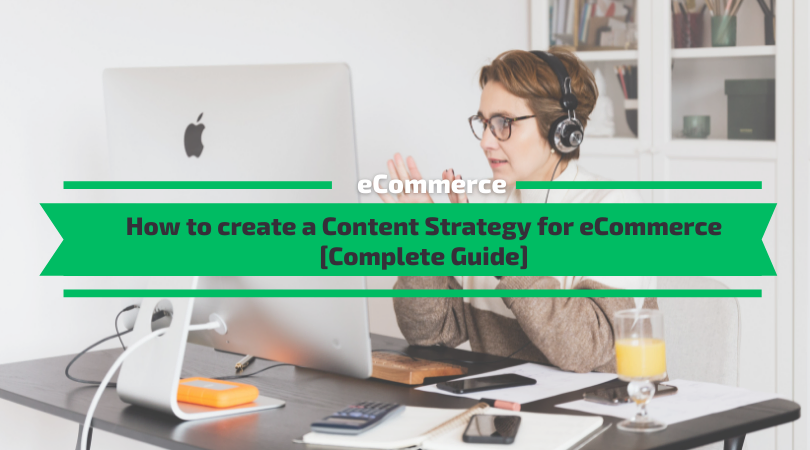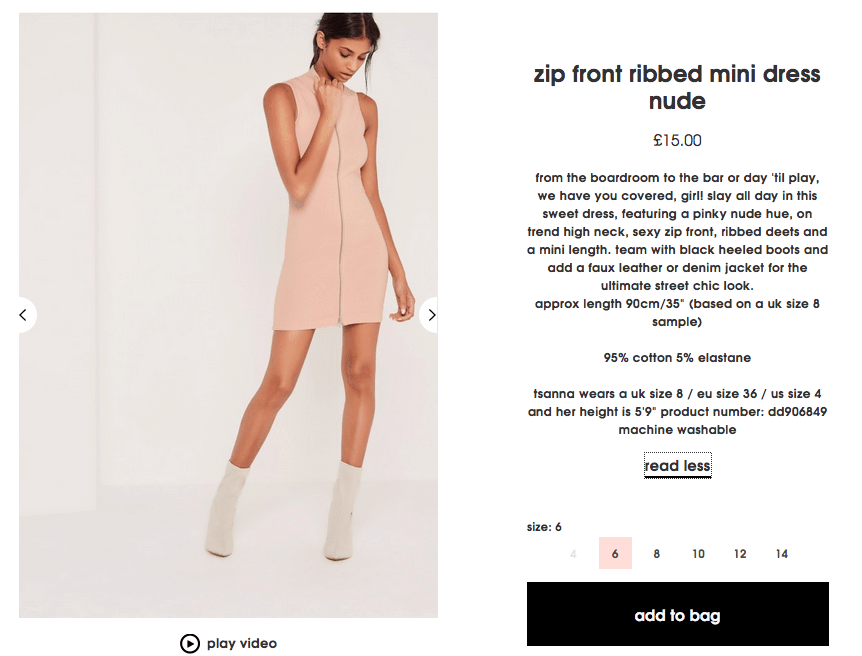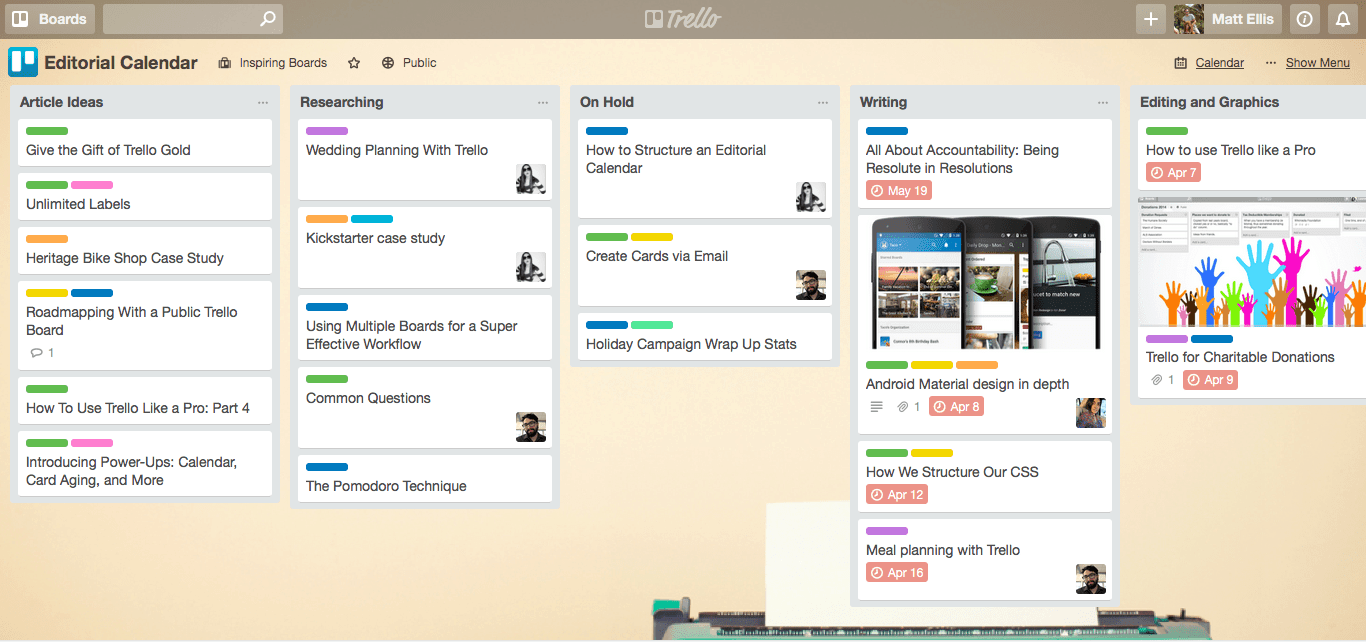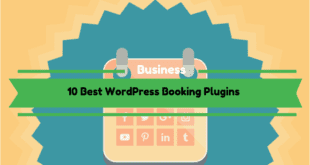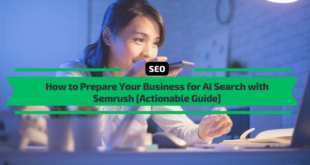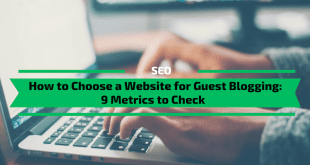The importance of content marketing for eCommerce brands has been significantly growing.
Content marketing is one of the most effective ways for retail brands to market themselves. The customer chooses only to interact with the content that interests them (like quizzes, for instance) instead of traditional marketing.
To illustrate: if you’ve never heard of Monetize.info before reading this post, well, you have now because of our content strategy.Statistically speaking, content marketing can increase your conversion rate to almost six times. The average conversion rate of sites with content marketing is 2.9%, compared to the average of places without a content strategy, 0.5%.
That reason alone is enough to put into action (and perfect) a content strategy, but it’s not the only reason. Content marketing becomes more and more crucial to a brand’s success every day, especially in the eCommerce sector. Tech and digital marketing guru Marsha Collier summed up why the strategy works:
Content-based marketing gets repeated in social media and increases word-of-mouth mentions; it’s the best way to gather buzz about a product.
The amount of daily time adults spend on digital media steadily rises and has almost doubled from 2.7 hours in 2008 to 6.35 hours in 2019. It’s easy to leverage some of that time into content from eCommerce stores.
Here is the best guide on building and executing the best content marketing strategy for repeatable growth — geared specifically for online retailers.To start things off, we’ll explain precisely why serious eCommerce brands should invest in content marketing.
Table of Contents
#1 Why Every Brand Needs a Content Strategy
The research keeps piling in to prove the effectiveness of content marketing.
The beauty of content marketing is that it enhances every aspect of your brand. There’s more to it than just increasing the bottom line; because the content speaks directly to your customers, there’s a direct connection that appeals to them on a deeper level than traditional avenues.
This significantly improves communication between brands and clients, both in what you say and how strongly it impacts them.
Just look at the findings from Demand Metric:
- Content marketing generates approximately three times as many leads as traditional marketing.
- Content marketing costs 62% less than traditional marketing.
- 82% of consumers have a more positive opinion about a company after reading custom content.
- 70% of consumers feel a closer connection as a result of content marketing.
- 60% of consumers enjoy reading related content from their brands.
- 70% of all people prefer to learn about a brand through articles than advertisements.
- 72% of customers believe they form a relationship with a brand as a result of custom content.
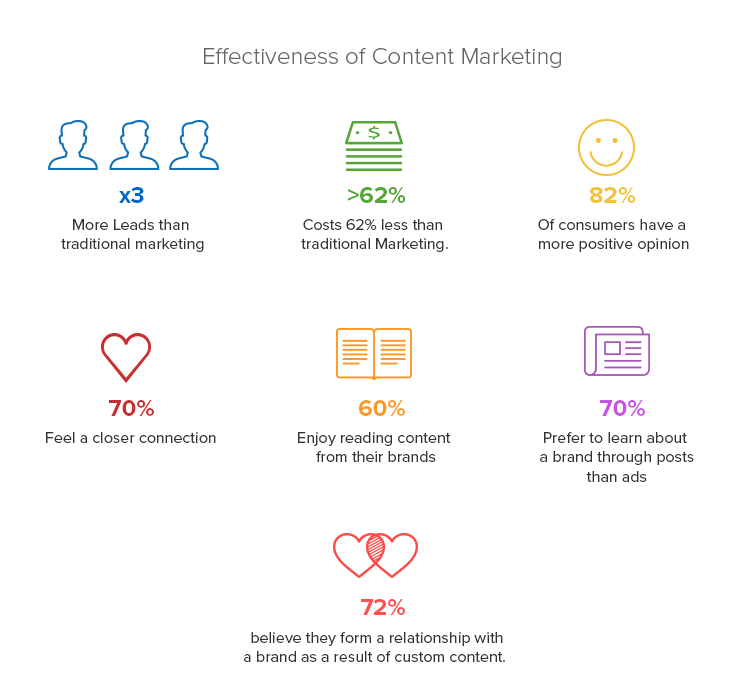
Let’s take a look at what Inc. Magazine says are the universal benefits of content marketing. We’ve listed them below.
1.1 Brand Awareness
As Demand Metric documented, the customers feel a closer and more positive connection with brands that produce custom content, making content strategy an invaluable tool for strengthening customer relations.
The more successful your content, the more people will remember your brand and create positive associations.
If you go the extra mile to publish authoritative content such as how-to guides, you can even be seen as the go-to expert in your niche, which means repeat business every time the customer has a relevant question.
1.2 Search Engine Optimization
Publishing textual content will, at the very least, boost your SEO. A subtle and cleverly conceived keyword plan threaded throughout your content will cast out more nets to catch browsers and potential clients.
Remember, the operative word is “subtle” — overloading your posts with keywords won’t go unnoticed and may hurt your reputation.
1.3 Expand Your Customer Base
Social media is, after all, a great way to make new friends and meet people. Reaching out to customers on social media, having your articles reposted, and guest posting on friendly sites are all excellent strategies for attracting new business and getting your name out there.
Even great content alone will achieve this. If your post shows value, it will be reposted and shared. An introduction to your brand through a meaningful article makes a solid first impression.
1.4 Relationships with Other Brands
Content marketing can yield better networking among companies in your industry and others. Opening up content exchanges and guest posting on other sites can benefit both brands, improve SEO results, and establish social proof in your customers’ eyes.
1.5 Influence Conversions
If people enjoy your content, they will feel a closer bond with the brand, trust them more, and be more open to conversions. A thoughtfully placed call-to-action or product link can be a keystone to your entire content strategy by directing users where you need them to go.
As we explain below, this is especially useful for eCommerce brands as you can guide the customer through the buying process with the right content at each stage.
1.6 Build Loyalty
Great content brings customers back after purchase and makes your brand useful beyond just having products to buy. This helps you generate repeat purchases and increase the lifetime value of your customers.
1.7 Compounding Returns
The deeper you understand content marketing, the more you realize it’s a strategy of compounding returns. The content you publish yourself never goes away (unless you delete it), so your content strategy will get stronger and stronger if you continue to post regularly.
This is doubly true to evergreen content, or content that is always popular.
For example, a fashion boutique might post an article about how to dress for your body shape. This topic will always be relevant to shoppers instead of a piece like “the best trends for summer 2020,” which will fizzle out fast.
#2. How a Content Strategy Can Help eCommerce Specifically
For eCommerce specifically, content marketing can make or break success.
Here’s what research from Demand Metric and ReferralCandy say about content marketing for eCommerce brands:
- 60% of people want to seek out a product after reading about it.
- 90% of people find custom and related content useful.
- 86% of consumers are willing to pay more for a better customer experience.
Every salesperson worth their paycheque knows that sales are about establishing an emotional connection. This makes content marketing even more effective, given its nature with the customer.
Content marketing personal link influences quite a few different aspects of the sales process, providing multiple benefits:
2.1 Product research aids.
Did you know that 81% of shoppers conduct online research before buying?
Even more interesting is that 60% of consumers start product research on a search engine. That means companies with an effective content marketing strategy have a better chance of attracting these shoppers to their site early on in their process.
Content like buying guides or product reviews is just helpful to shoppers in general. As mentioned above, if you show how useful you are in product research, you can establish yourself as an authority and generate repeat visits and business.
2.2 More effective style of sales pitches.
Customized content makes better sales pitches because you’re teaching instead of selling. Your customers will appreciate an informative and engaging piece of content much more than a direct sales pitch. That’s the advantage of content marketing in a nutshell: it promotes your brand in a more user-friendly way.
2.3 Enhances the shopping experience
When it comes to shopping, many people, especially women, enjoy the experience and the result. Worthwhile content enhances the experience all across the customer journey with insights and entertainment. Even the availability of relevant content gives users the option to scale up or down the amount of time they spend shopping.
2.4 Show products in context.
Personal and casual content can show your products in context and demonstrate their value in more meaningful ways.
The stronger emotional tie lets the shopper imagine more clearly what owning the product would be like for them, specifically, usually increasing the urge to buy.
Another advantage is that the content can inform shoppers how to use the product or features they may not have been aware of.
2.5 Product videos
One type of eCommerce content, the product video, has well-documented benefits on sales:
Benefits of Video Content for e-Commerce
- 73% more shoppers will buy after watching a video.
- Videos appear in 14% of search results.
- Almost 46% of shoppers will buy a product in-store if a product video is unavailable.
- 71% of shoppers believe videos explain products better.
- 57% of buyers are less surprised by-products with videos.
- 58% of shoppers view companies with product videos as more trustworthy.
If you think product videos are effective on their own, imagine how much stronger they are when incorporated into a greater product strategy.
The Will It Blend? The Video series from Blendtec is a praiseworthy campaign. Each installment features the company’s founder putting strange objects into his blender. The appeal of watching a blender destroy fun objects made the show a smashing success, but the series also shows off the product’s durability and strength. The “Justin Bieber” episode above earned more than 3.6 million views.
2.6 Timely boost at each stage of the sales funnel.
Perhaps the greatest advantage of content marketing in eCommerce is ushering shoppers along the sales funnel.
This is a complex topic, and we will discuss it more thoroughly in its piece in the future.
For now, though, he’s an abbreviated explanation of what content marketing can do for the sales process:
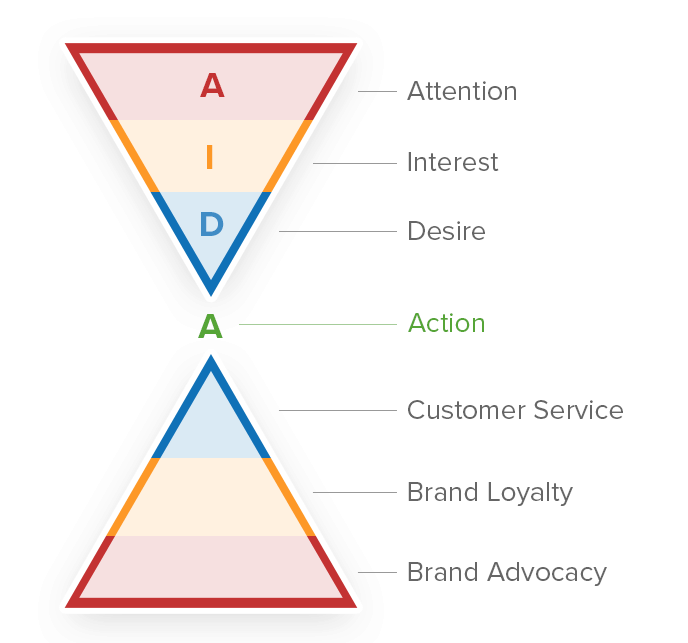
- Awareness — Getting your content out to new channels: posts shared on social media, guest posting on friendly sites, or even just a potent SEO strategy.
- Interest — Informative posts: how-to guides, buying guides, quizzes, helpful widgets. Social proof: user reviews, critic reviews, testimonials, case studies, or simply base popularity with social media followers. Product information: product videos, clever product descriptions, engaging product photos.
- Action — Campaigning: announcements for sales or everyday low prices. They are facilitating the buying process: more accessible CTAs, single-click buying, streamlined checkout process.
- Customer Service, Loyalty, and Advocacy — Customer satisfaction: social media referrals, social proof on social media, faster and more efficient customer service.
Because this topic warrants more explanation, we’ll give it its article soon.
#3. Content Marketing vs. Paid Advertising
This heading is unfair. It shouldn’t be content marketing versus paid advertising because the two aren’t competing. They work best together; they complement each other.
We’re just going to compare them so you understand the true effectiveness of content marketing.
As you can tell from the statistics above, content marketing seems to resonate more with consumers than other advertising forms. A late 2015 Nielsen Norman Group study confirmed this assessment: recommendations from friends, editorial content, and online consumer reviews — along with branded websites themselves — all scored higher in trust levels than all other forms of advertising.
Furthermore, Neil Patel praises the return on investment (ROI) of content marketing, though he admits that your content strategy must be sound. He points out that paid advertising will generate significant but short-lived spikes in leads, whereas content marketing produces a slower but more reliable climb.
Then there’s the matter of banner blindness, where 86% of consumers have been trained to ignore online ads. And this doesn’t even account for ad-blocking software. There are indeed ways to get around banner blindness, but the point is customers don’t ignore content — in fact, they seek it out themselves.
Finally, customers spend far more time interacting with custom content than ads — about 345 times longer. This equates to more time engaging directly with the brand, and if the content is on your blog, more time on site.
In defense of paid advertising, content marketing doesn’t usually yield the direct results of paid advertising, and conversions tend to take longer. As Dan Norris, co-founder of WPCurve, explains:
“Some of our customers had been following my content for five years before they signed up. Your ideal customers will hear about you over a long period of time, through multiple sources, and that is how trust is built.”
Content marketing often requires multiple touchpoints over a longer period, whereas paid advertisements like Facebook ads or Google Adwords instantly produce leads. That’s why we recommend doing both types simultaneously rather than relying only on one.
In the grand scheme of things, you’ll need to do both and balance the investment for what works best for your business. You can allow the necessary funds for a working content strategy and reap the benefits that traditional advertising can’t offer: long-term results, better customer relations, better branding, more time on site, SEO, etc. But you can also work a content strategy into your existing advertising framework.
#4. How to create and optimize your eCommerce Content Strategy
Now we’ll lay out a 6-step method for optimizing eCommerce content strategy for your specific goals, industry, and resources to help ensure you can maximize the results you get from your investment in content marketing.
- Know Your Shoppers by Creating Personas
- Define Content Goals
- Organize Content by Channel
- Team-building and Promotion
- Use Customer Journey Maps to Create Content
- Make a Calendar
You don’t need to be a natural-born Kardashian to produce content that your shoppers care about. All you need is to apply the same business know-how to content marketing as you do to your online store and products.
Step 4.1 – Know Your Shoppers by Creating Buyer Personas
“There is only one boss. The customer. And he can fire everybody in the company from the chairman on down, simply by spending his money somewhere else.”
Sam Walton, Founder of Walmart and Sam’s Club
The heart of all business is, of course, the customer.
Chances are, you’re not going to market your store to everyone. It’s hard to be the Beatles of eCommerce, so it’s better to focus your efforts on only your target customers rather than trying to please everyone.
The more specific you get about who you want on your site, the more effectively tailor your content strategy.
Nailing down your ideal customer can be one of the trickiest areas, full of abstracts, guesswork, and dead-ends. That’s why buyer personas are so important — they keep logical thinkers grounded in evidence-based data instead of shooting in the dark. A Marketing Sherpa case study showed that using personas increased:
- time on site by 900%
- marketing-generated revenue by 171%
- the email-open rate by 111%
- the number of pages visited by 100%
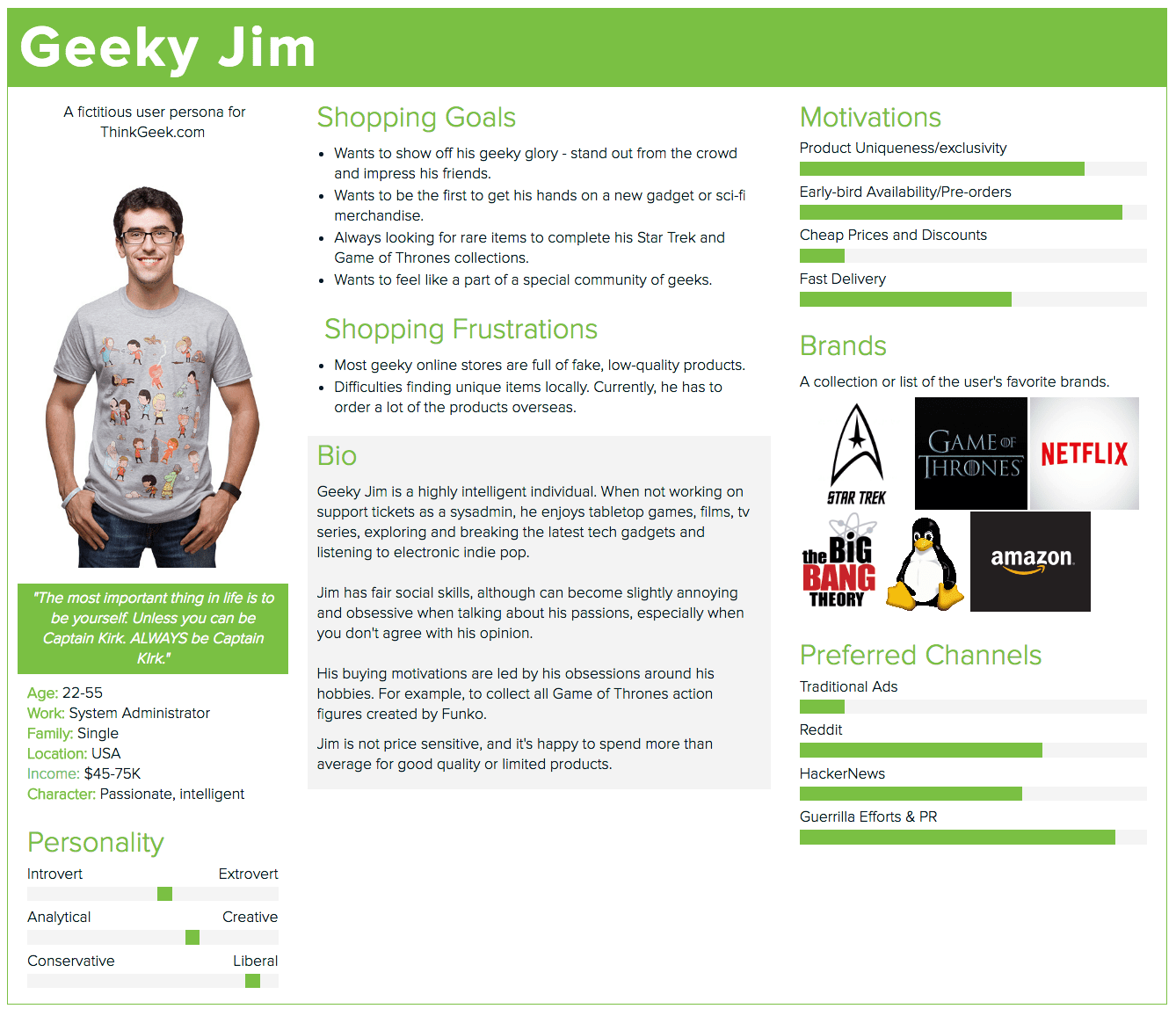
A fictitious buyer persona for ThinkGeek.com. Created with Xtensio.
Check out our example eCommerce user persona for Geeky Jim.
Personas are fictional representations of real target users, written as documents that can be referenced any time you’re making consequential decisions. Typically, you should have one persona to represent each group of target shoppers.They can be as simple or complex as you need, but in general, should contain the following information:
Details you need to create a persona
- Name & Photo — These help in imagining your personas as real people instead of just datasheets.
- Demographics — Gender, age, income, location — any concrete data that can better inform the type of content they want.
- Personality — Include a few metrics to describe the user’s personality, which significantly impacts their behavior. Traits like “lazy,” “ambitious,” “skeptical,” and “enthusiastic” all lead to different styles of content.
- Motivation — What do your shoppers want to accomplish? Do they enjoy the act of shopping or want to get it over with ASAP? Do they want to learn more about the products/industry, or do they know enough already?
- Frustrations — The side of the coin opposite motivation. User pains are a significant influencer for shopping, i.e., what problems does your user have that your content and store can potentially solve. For example, maybe they’re too confused about how a product works to buy it. Perhaps they want more structure in their life and don’t yet know that your product range can help them get organized.
- Preferred Sites and Apps — Knowing where your shoppers hang out on the web tells you how to reach them. Are they the Snapchat generation, or have they just joined Facebook recently? How often do they post to Instagram? What posts are the most likely to Like?
- Personal Quotes — Adding a personal quote or motto also helps to breathe life into personas. Something like “If I don’t know something, I Google it” sheds a lot of light on both browsing and shopping behavior.
Before diving in headfirst, don’t forget the golden rule of personas: always use accurate customer data. Personas are only as valuable as the data. Extensive customer research reveals, without a doubt, how your customers behave and, more to the point, the most effective type of content for their group.
An in-person interview will give you a hands-on opportunity to directly ask your customers the questions you want to know, as well as gently guide them to elaborate and go into detail.
This requires an investment of your time, but it’s one well worth making.
Step – 4.2. Define Content Goals
The next step is to establish realistic goals for your content. What do you want your content to achieve?
The beauty of content marketing is that it can be applied throughout the buyer’s journey, offering different rewards at different stages.
Here, we’ve listed some common goals about the purchase funnel to help get you thinking:
Common Goals Of your Purchase Funnel
Awareness
- Improve reputation for collaboration opportunities
- Improve search engine optimization
- Drive traffic to your blog
- Raise brand awareness
- Change the brand image
Interest
- Drive traffic to your store
- Increase email sign-ups (accounts, newsletters, etc.)
- Increase social media popularity (followers, Likes, etc.)
- Share brand news (events, new products)
Desire
- Promote a campaign (sales, deals, coupons, etc.)
- Aid purchase decisions (buyer guides, product comparison charts, etc.)
Action
- Drive traffic to a specific product page
- Embed buying options on external sites
Advocacy
- Improve customer service
- Improve loyalty/repeat business
- Increase word-of-mouth advertising
Try to be as detailed as possible when deciding your goals. The more specific you are, the better you can customize your content strategy with your target customers. Knowing your goals will help when it comes time to build your content — especially when choosing the page your content directs to.
Step 4.3 – Organize Content by Channel
Take your target shoppers, add your eCommerce content strategy goals, and the result is a clear idea of what and where to showcase your content. Step 3 is the real meat of your overall content strategy, where you get down to the Knitty gritty and start making the crucial decisions.
To start, we can divide the content distribution into four channels: owned, earned, paid, and shared.
4.3.1 Owned
Owned content is everything from your brand. This includes your site’s blog and social media accounts, as well as the actual content on your site, such as product descriptions.
Source: “Blog Ideas.” Owen W Brown. Creative Commons.
For your blog, you want to come across as an authority in your niche. No matter your specific goals, you’ll want to aim at being a go-to source for all things related to your product range. This can be more than just posting how-to articles, guides, industry news, and sometimes opinion/editorial pieces.
[https://vine.co/v/57rgr95hpUp]The home improvement store Lowes fills their Vine page with one-off tips handymen will appreciate, such as “Get crafty when caulking by using a popsicle stick for a smooth, professional finish.” These are usually accompanied by engaging animations, making them informative, fun, and relevant to their target customers.
As for social media, don’t forget to give as well as receive. Active social media is more than just posting regularly — it’s also interacting with fans and other content besides your own.
For more thorough advice on your brand’s content, read our article How to Boost Your Ecommerce Brand with Content Marketing.
4.3.2 Earned
At this point, make a list of both the top sites in your industry and the top influencers for your type of product. After removing your direct competition, the remainders will be your potential collaborators.
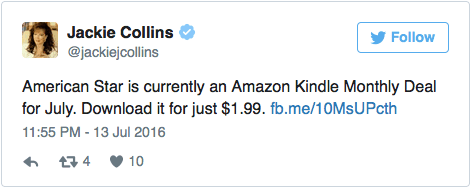
Author Jackie Collins promotes herself and Amazon with a link to a product that gives them both money.
Later, you will want to reach out to them for mutually beneficial partnerships, including article exchanges, social media promotions, and joint marketing campaigns (such as a shared ebook).
4.3.3 Paid
Allocate a portion of your budget for sponsorship on sites popular with your target shoppers. Besides general advertisements, you may need to promote more particular content, such as a contest, promotional ebook, or even a price promotion.
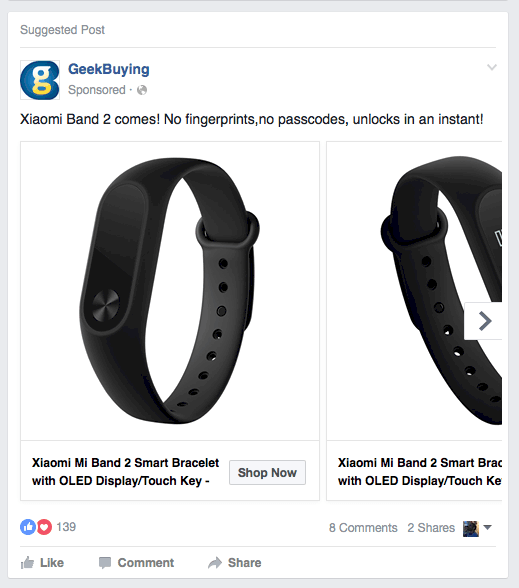
Source: Facebook
Even if you’ve got a limited budget, sponsorship doesn’t have to be expensive.
Most effective advertising channels and even many smaller networks allow you to start small and scale up as you uncover the most effective paid channels and tactics for your business.
4.3.4 Shared
The last channel for content is providing your customers and visitors with the chance to create their own. This goes beyond merely allowing comments and reviews — savvy marketers must actively encourage visitors to interact.
Source: Brita, Lynn. Instagram.
One of the most effective methods, for example, is to offer contests or deals for users who post their products.
In 2014, Starbucks hosted one of the most successful user-generated content campaigns in history: the #WhiteCupContest to see who could create the best original design on their plain white cups — and submit the picture of their entry on social media. In just three weeks, they racked up almost 4,000 entries.
Step 4.3.5: Choose a Tone
There’s something worth mentioning quickly here. While you’re creating your distribution plan, starting considering the tone of your content. Your content is the voice of your brand, especially on external sites, so don’t take this decision lightly.
While you’re free to change up the tone depending on the type of content and where it’s displayed, it’s best to stay consistent for more robust customer loyalty.
Knowing your customers is the most significant influence on tone. Do they want a younger, casual voice that uses slang and emojis or a more professional and traditional agent (better for high-end purchases to a more mature audience)?
Source: Missguided
Source: Missguided
The UK’s Missguided maintains the same casual and edgy voice as its young shoppers use themselves on social media. The tone remains consistent on all of its content, from its product descriptions to its Instagram.
Step 4.4 – Team-building and Promotion
Congratulations. You have your plan, and now it’s time to put it into action. Content marketing is not something you need to do alone, so get out there and start making friends.
For your content, this could mean hiring new staff. Depending on your strategy, your team might involve different types of specialists:
- copywriters
- graphic designers photographers
- photographers
- filmmakers (the size of the group varies)
- social media managers
- radio/podcast hosts
- shopping experts (for buying guides)
While it’s possible to start very small and straightforward, keep in mind that your results will be heavily influenced by the amount of time, effort, and money you invest.
When possible, work with experts with a proven track record delivering the types of content you believe will work best for your target audience.
Building collaborations with other sites and influencers requires a bit more effort and even some finessing. Drawing on previous connections and networking is an excellent place to start, so first, reach out to any friends you already have in the industry. You can even put out feelers for introductions with friends of friends.
For article sharing and similar partnerships, even cold emails can work well, given that both parties stand to benefit. First and foremost, look within sites related to your niche that are complementary to your own.
Getting influencers on board may take some elbow grease. A common tactic is to give them a gift of the product you’d like them to promote, but there’s no guarantee they’ll play ball (it is, after all, a gift).
If they’re a social media influencer, offer them the opportunity to increase their following, either by exposure on your site or even a joint campaign.
Source: Negin Mirsalehi. Instagram.
For example, when the clothing retailer REVOLVE wanted to expand from the west coast to the east coast, they threw an East Hamptons party and invited a handful of top-tier fashion bloggers. By the end of the summer, most of the clothes (gifts) worn by the bloggers in their famous Instagram accounts had been sold out.
As for sponsorships, it’s pretty straightforward. You may already be doing some advertising, so this is about testing out different tactics and types of content to expand on what you’ve done in the past.
Step 4.5 – Use Customer Journey Maps to Create Content
Now, it’s time to construct the actual anatomy of your content posts. No matter whether you’ve decided on blogs, videos, or a series of kitten photos, you can maximize your results by using user journey maps.
A customer journey map is an empathy exercise to help put you in the customer’s minds as they experience your content. It lists out, step-by-step, what your customer does (and thinks and feels) at each stage. Typically, user journey maps are created using existing personas.
Below is an overly simplified example, but user journey maps can be more involved and even include customers’ inner monologues.
- Francesco, the Fashionista, is looking for a new pair of pumps that match her very high criteria.
- She goes to her favorite fashion site and browses the article titles until she finds one that stands out.
- She reads the article, which includes images, descriptions, and links to all the shoes mentioned.
- Then she finds a pair she likes and clicks the link. It takes her to the product page.
- Deciding the price is manageable, she completes the purchase.
Source: “LK Bennett Nina Open Toe Pumps.” SPERA.
This may seem brisk, but there’s a lot of information we can get from this small exercise that will help adapt our content to specific goals:
- Which site to publish on (“her favorite fashion site”)
- How to title the post (something that sticks out to people looking for pumps)
- What to include in the post (images and descriptions)
- Where to direct the inbound link (the product page)
- It even adds some insight into other areas of business, such as pricing.
Get into the habit of mapping out the user journey for every piece of content you put out there, even if just a short version like the above. Taking a moment to empathize with your customer will always pay off.
Step 4.6: Make a Calendar
Last, you need to publish content regularly and measure its impact. The amount of content and the frequency you post will vary depending on your level of investment.
And remember, eCommerce content strategy is not something you do once and then let stagnate — it involves constant maintenance, regular updates, and vigilant scrutiny to see what’s working and what’s not so that you can continuously optimize.
Keep a tight ship. Regularity is integral for social posting, and fans get irritated at late and irregular posting. On the plus side, reliability and consistency are rewarded with loyalty. Mark all your post schedules on a calendar, and make sure nothing slips through the cracks.
It helps to have a stockpile of content lined up in case of emergencies and unforeseen obstacles. It’s an excellent safeguard against missing deadlines.
#5. Map Out Your eCommerce Content Strategy Now
As a successful online retailer, you may have built your business based on more traditional marketing approaches. To take your business to the next level, you’ll need to master the art of content marketing.
And if you’re running a digital agency focusing on eCommerce, helping out your clients with content marketing is an excellent source of retainer-based revenue if you do it well.
We hope you find our 6-step method helpful, and it inspires you to either get started or step back for a critical review of your current strategy if you have one.
And stay tuned. We’ll be following this post with more detailed articles on best practices for executing your eCommerce content strategy at every stage of the buying funnel in the coming weeks.
Do you have a content strategy for your online store?
Share details on what is working for you in the comments if so to help others learn.
 Monetize.info We Help You Monetize Better Your Digital Assets! 💰👍
Monetize.info We Help You Monetize Better Your Digital Assets! 💰👍

